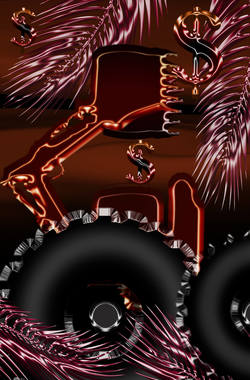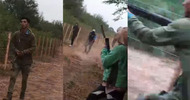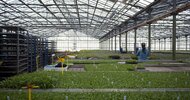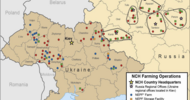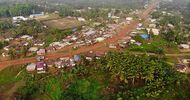The Baffler no. 63 | May 2022
Bitter Fruit: The palm oil industry remakes Guatemala
by Alessandra Bergamin
WHEN THE Q’EQCHI’ FIRST MOVED NORTHWARD, to a place then uninhabited, the land was tranquil and bountiful. There was maize to harvest, leafy hierba mora to forage, deer and the spotted tepezcuintle rodent to hunt. If you wanted fish, there were plenty. If you needed water for cooking, bathing, or drinking, it was abundant. But there was a rule: no one was to submerge themselves in the small river that cut a winding path through the indigenous community’s new land. There was no name for this seeming paradise, so the self-described community of believers turned to a place that Jesus once walked and christened the village Palestina II—the second Palestine. There was no way to know then that a blessing could become a curse.
Beneath the shade of a thatched-roof palapa, the glowing embers of a low burning fire at its center, Maria Alciro Bolon stirs a blackened pot of atol de plátano—a thick, spiced plantain drink—from which steam rises in swirls amid the torpid September air. Around her, tan and black mutts slink under tables in search of scraps and affection. A teenage girl molds fresh dough into round tortillas. Outside, a water delivery truck rumbles along the white gravel road that skirts the outdoor kitchen and divides the center of Palestina II.
In lilting Q’eqchi’, Bolon, a community leader, welcomes a dozen or so women, each wearing a bright lace huipil top and woven skirt that skims the ankles. Some arrive with babies slung across their backs, their dark hair tousled by sweat. With a broad, gummy smile, Bolon greets Maria Tec Pop—an older woman with dark hair pulled taut at the nape of her neck and gold stars pressed into her front teeth. Both hold a seniority that stretches back to the founding of their village some thirty years ago. They remember a time when everyone had land to cultivate, when the water was carried by current and not by truck. They remember Rudy—the man with the light-colored eyes.
He was an intermediary. A ladino. Someone who was not indigenous, as they were. He arrived in Palestina II hoping to buy land from a community who had only just acquired it. During Guatemala’s thirty-six-year civil war, Bolon, Tec Pop, and many other Q’eqchi’ left their native home in the region of Alta Verapaz and followed the mountain’s slope north to the country’s largest department, the Petén. In the southern swath of this green sea, in the place they called Palestina II, they found the land they had been systemically denied elsewhere. It would be theirs to borrow, to pass on, Bolon says. When Rudy made his offer, the community refused it. As a people repeatedly displaced for some five hundred years, a people who bind the word loq’laj, or sacred, to ch’och’, or land, the Q’eqchi’ would not cede it so easily. They did not expect that the ultimate deceit would come from one of their own.
Now seated on a wooden bench, with Tec Pop to her right and a tower of empty plastic cups, sticky with atol, on a table to her left, Bolon tells me about the man from Palestina II. Tasked with persuading the community to sell their land, he promised they would be paid very well. Some, trusting their neighbor, decided to sell and made hopeful plans to rent land elsewhere. Others refused. Then came the threats. As each plot of maize, each square of tilled earth, was encircled by private property, families such as Bolon’s were warned that should they cross land they did not own, something might happen. In Guatemala, such implications are not made without intent, and one by one, most people in Palestina II agreed to sell. But two families fought to keep their land. One of them was Bolon’s.
At the furthest boundary of her family’s home—past the palapa, past the muddied, free roaming chickens, past the children climbing skinny trees that buckle beneath their feet—begins a contested terrain. It is an uninterrupted landscape of short, stout palms that unfold in waves of curved frond and feathered leaf. Each former patch of family farm in Palestina II has become part of a palm plantation, transforming a harvest of subsistence into one of capital. It has placed the hunger of a global industry on Bolon’s doorstep. And even the protected, the revered, is now imperiled.
Bordered by palms, the only river in Palestina II is an opaque, oil-slicked symbol of what has been lost. Once used for cooking, cleaning, bathing, and drinking, the river’s water is now said to cause unexplained fish die-offs and irritating rashes that spread across the body. The skin bleeds, I am told. The women of Palestina II suspect it is the palm pesticides and poison used to keep rats at bay. They have told the company, Nacional Agro Industrial, S.A., that the plantations inch too close to their homes and their river. They have spoken of it, again and again, making their desire, their unwavering demand, known—the palms should not be here. But no one will listen, Bolon says. The companies do not care about the people of Palestina II. It is the fortune of a few pitted against the burden of many. And the palm oil industry is nothing if not rapacious.
Making a Killing
It is something of a universal truth that in 2022, palm oil is as ubiquitous as it is despised. Every palm economy, from the burgeoning industry in Guatemala to the epicenter in Indonesia, is plagued by problems borne from and enabled by the world’s appetite for cheap vegetable fat. Industrial palm oil is now found in about 50 percent of supermarket products, from cookies and peanut butter to shampoo and lipstick. While the oil itself, extracted from the flesh of the red, bulbous palm fruit, is a beloved local staple across its native West Africa, the industrial ingredient—the version most people consume—is the byproduct of violent processes inflicted on man and earth.
Land grabs displace communities. Monocultures strip biodiversity. Pesticides poison waterways. Workers are exploited for cheap labor in dangerous jobs. Some prosper, most do not. Dissenters are silenced. Palm oil is produced. Profits are made. It is a cycle steeped in colonialism and perfected by modern global capitalism, a cycle that relies on the violence of extraction to succeed. It is no coincidence that across the world in 2020, the number of land defenders killed while opposing agribusiness matched those killed while opposing mining and other extractive industries.
But even manufactured landscapes require more than brute force to succeed. In the palm oil industry, image control is a means of survival, and what is said—on billboards, at meetings, online—can be even more nefarious than what is done. Corporate interests are branded as sustainability. Unmet promises are advertised as reality. And the world, desperate for a reprieve, deems these efforts a “solution.” But someone like Bolon knows otherwise.
Toward the end of the palapa gathering, before a lunch of chicken soup—the best parts divided evenly amongst those present, as is the Q’eqchi’ way—I ask if the palm plantations have brought any benefits to Palestina II. A room full of women shake their heads. Bolon says that whatever I have been told is not true. She has been invited to something called an “environmental workshop”—an event met with indignation by the indigenous community. She has seen the roadside billboards that announce the palm company’s acts of charity: a new water tank installed, a dirt road repaired. She has even been to meetings at which the company boasts about these very contributions, about all they have done and all they have spent. But the palms still surround the homes of Palestina II. The river is still unusable. The threats still hang heavy. No one is fooled.
“We have nothing,” Bolon says. “And they are the ones who are killing us.”
Chainsaw Massacre
About an hour north of Palestina II, the town of Sayaxché tumbles forth from the banks of the River Pasión, a cacophony of crowded buses, dusty country trucks, and cramped two-wheeled motos that sway along wide dirt roads. Sayaxché is something of an agro-industrial frontier, where street vendors hawk raw chickens and used bras, men in high-crowned cowboy hats chat outside carnicerías, and stores adorned with hand-painted signs advertise everything from the cost of a haircut to Bayer pesticides. On a stifling Sunday morning, halfway down a street of hotels and tiendas, I meet Ramiro Hernández at the town’s most popular café.
A local leader elected to a rural community development council known as a COCODE, Hernández arrived in Sayaxché in early 1986 planning to stay just a few months. Then he saw the trees, the deer, the river, the coyotes, and fell in love with a place that was then beautiful. But about six years into his pastoral life, Hernández began to hear chainsaws. There was a constant and unfamiliar revving, whining and slicing through the peace of his chosen home. It used to take quite some time to fell a tree. Men equipped with a few saws and an ax would build beds among the branches while they cut thick, towering cedar and mahogany from top to bottom. But with the arrival of chainsaws, people were hacking through the forest fast, destroying, destroying, destroying, Herndández says, until there was nothing left.
At the time, the Petén—making up one third of Guatemala but home to around 3 percent of its population—already had some exposure to palm oil. One of the country’s biggest landowners, the Molina family, introduced the African palm to replace their cotton crops in the late 1980s. But the region was still mostly cattle country. Since the 1960s, about half of the once densely forested Petén had been cleared for livestock. In a familiar approach, ranches big and small capitalized on preferential government programs and adopted aggressive tactics to acquire land. But while ranchers purchased land family by family, the palm companies that followed could buy up entire villages. Between 2003 and 2013, land for palm oil cultivation almost quadrupled across the country. Today, Guatemala is the world’s sixth largest palm oil producer, exporting about 80 percent of its palm crops as crude oil to Mexico and a handful of European countries.
“We’re surrounded by palms on all sides,” Hernández says. “Everywhere.”
Across Sayaxché, across the Petén, these palms replaced and repurposed, if not completely, former cattle ranches. But the plantations have also absorbed land that was once used to grow maize and beans as part of the milpa crop system, or land that was left to fallow between harvests. In Sayaxché today, farming for crops like corn, beans, and plantains is no more than a memory, Hernández says. But it would be remiss to say that the Petén is barren, empty, or untended. Palm plantations have replicated the idea of a forest in much the same way that industrial agriculture has redefined what it is to feed people. Both use the illusion of abundance to mask extractive practices that undermine local food production.
At the café in Sayaxché, just four blocks from the Pasión’s edge, Hernández maps out the river and its tributaries, tracing an outline across a woven pink and red tablecloth. Green-gray and sinuous, the Pasión ripples, wrinkles, and unfolds for some two hundred miles across the Petén. It originates from north-flowing headwaters that skirt Sayaxché and tend westward before feeding into Mexico’s Usumacinta River. In Sayaxché, where there is no bridge that spans the river’s wide banks, people are ferried across on painted wooden boats, while cars and trucks—loaded with cows or bunches of red palm fruit—are carried by barge. Not so long ago, Hernández says, the river was filled with all types of fish, good fish, the kind that communities living along the water’s edge hedged their livelihoods against. But seven years ago, all of that changed.
The Pasión of Petén
In June 2015, during the Petén’s rainy season, the oxidation ponds at a local palm plantation and mill overflowed, spilling a biocidal blend of the insecticide malathion and palm effluent into the waterway. Palm effluent is made up of organic waste generated by the process of turning palm fruit into oil. Left untreated, it is one hundred times more polluting than domestic sewage. Soon there were thousands of dead fish carpeting the surface of the Pasión and a foul stench hanging in the air. Rigoberto Lima Choc, a twenty-eight-year-old schoolteacher and activist, was among the first to witness and document the destruction. One hundred miles of the Pasión were poisoned. Twenty-three fish species were decimated. And a score of indigenous communities, reliant on fish they could no longer catch, were ruined. Across Sayaxché, a new term emerged: ecocide.
Over the following months, mounting evidence traced the spill back to the largest palm producer in the area, Reforestadora de Palma del Petén S.A, or REPSA. Owned by the Molina family as a subsidiary of the agro-industrial company Grupo HAME, REPSA occupies about 10 percent of the land in the Sayaxché municipality. While land is power in Guatemala, especially when its unequal distribution favors the rich, activists including Hernández and Lima Choc demanded that the company be held accountable, if not permanently closed. In September 2015, three months after the spill, a Guatemalan judge ordered REPSA to temporarily cease operations while an investigation took place.
It never happened. The following day, three activists were kidnapped while on their way to Sayaxché. In town, six hundred REPSA workers, aggrieved by the proposed closure and possibility of a mass dismissal, held those inside a local government building hostage. The Office of the United Nations High Commissioner for Human Rights called for the government, at any level, to intervene. But there was no response. Around midday, when the sun was at its highest, Lima Choc was gunned down outside Sayaxché’s Courthouse of Peace. The masked assailants fled on motorbike. The kidnapped activists and the hostages were released. REPSA denied any involvement, and no one was ever charged.
Over the next three years, as Nestlé and U.S. food giant Cargill severed ties with REPSA, the company embarked on a sweeping public relations campaign. It adopted a policy on non-violence and intimidation, established a sustainability plan, and produced a twelve-minute video shirking responsibility for the contamination of the Pasión, instead laying blame on riverside communities. A Sayaxché tourism website, created a year after the ecocide but with no overt ties to REPSA, regurgitated the company’s talking points. Posts on the site asserted that the pollution of the Pasión was an opportunity, not a crisis; others accused human rights activists of hate speech; and two exalted Lima Choc as a local hero while blaming his death on “falling in love with the least convenient person.”
REPSA’s revisionism has mostly succeeded. It has not been held legally accountable for the contamination of the Pasión nor admitted to any wrongdoing. Over the past three years, some of the corporations that cut ties with the company have reinstated them. Activists, meanwhile, continue to organize. But the violence in Sayaxché has made many a little more cautious. At our café table in the heart of town, Hernández speaks in a low, quiet voice, his words coming out just above a whisper.
“We are continuing to defend,” he says. “But we have to be more careful—where there’s palm, there’s violence.”
And, as I am told, the companies have ears everywhere.
Certified Cruelty
About thirty miles to the southwest of Sayaxché’s center, where the Chixoy river carves out a border with Mexico, the microregion of Tierra Blanca begins. Potholed streets, flooded from a morning downpour, are surrounded by languid dogs, brightly painted concrete stores, and sprawling palm plantations that operate under the dominion of the company Palmas del Ixcán. It is mid-October when I visit, hot and humid, and the air is swollen with listless mosquitoes.
At a sky-blue home in the village of Roto Viejo, I meet Vicente Pérez Ramírez, another leader of the COCODE. From his kitchen-cum-living room, a television plays a muted telenovela while Ramírez tells me about a meeting he was invited to three months earlier in Rubelsanto, about two hours away. Local leaders from across the region had been gathered to discuss Palmas del Ixcán. A “professional woman,” as Ramírez describes her, wanted to know what impact the company had had on their communities. No one from Palmas del Ixcán was present nor listening, they were told. The community leaders could speak freely. And their list of grievances ran long.
Since the plantations moved into the area about fifteen years ago, once more using intimidation and encirclement to buy land—including Ramírez’s small plot—the community’s conditions had worsened. Every summer, the nearby lake, shaped like a waxing crescent moon, is nearly drained to satiate thirsty palms. Flies, which many in the community believe are linked to the plantation, have descended in hordes. Workers, both local and migratory, are paid poorly, fired easily, and have to wade through deep drainage ditches of water laced with chemicals to meet daily quotas. Around the time of the meeting in Rubelsanto, the San Román River had been polluted, fish floating to its surface.
“The companies have only harmed the communities,” Ramírez says. “That’s their intention.”
The meeting had been held to discuss the potential certification of Palmas del Ixcán as a producer of sustainable palm oil. Since the mid-2000s, when deforestation and the demise of the Sumatran orangutan shone a light on the problems across Southeast Asia’s palm oil industry, demands for a more sustainable product have been addressed by the Roundtable on Sustainable Palm Oil, or the RSPO. Made up of different members from across the palm oil industry—growers, manufacturers, investors, and nonprofit organizations—the RSPO uses social and environmental criteria to assess whether a company produces what they deem “Certified Sustainable Palm Oil.”
Certification is a process that can take several months. It involves independent audits and community meetings such as the one Ramírez attended. About 19 percent of the world’s palm oil production has been certified sustainable by the RSPO, including more than ninety-five thousand hectares of palm-producing land in Guatemala. On paper, the global initiative looks both effective and commendable. But across palm-bound communities, in villages without water, in the homes of locals and land defenders, the reality is more complicated.
At Ramírez’s home in Roto Viejo, where a few boisterous roosters crow through the midday heat, we are joined by Raul—another community leader, who has asked that I only use his first name. Ramírez is part of the COCODE at the town level; Raul represents the twenty-two mostly indigenous Q’eqchi’ communities that make up the Tierra Blanca microregion. Like Ramírez, he attended the RSPO meeting about Palmas del Ixcán and, alongside leaders from two municipalities and two other microregions, signed his name to a letter addressed to the RSPO’s independent auditors. The letter detailed the damage caused to their communities by Palmas del Ixcán and listed recommendations for what should happen next: no new plantations; relocating a palm processing mill; reviewing work quotas for laborers; speaking with affected communities. And do NOT—as the signatories capitalized—certify Palmas del Ixcán.
After the meeting and the letter, Raul was approached by someone he knew worked for the company, who invited him to share a soda at a local tienda. Raul obliged, though he suspected it would not be a friendly encounter. The man listed Raul’s comings and goings from the municipal building, where he often went for work. In his hand, he carried a list of names, and Raul noticed his was marked. Without hesitation, he told the man he knew he was being investigated and intimidated by the company. But he had done nothing wrong. As a community leader, Raul always says, you “cannot serve two masters.” It is the plantations, or it is the people. And he will always choose the people.
“We are the owners of the land. They see us as enemies,” Raul says of companies like Palmas del Ixcán.
In Roto Viejo, as the smell of lunch brings the conversation to a close, Ramírez questions why someone from the RSPO—from their Guatemala office, from overseas, from anywhere—doesn’t visit communities like his. If they did, he says, they would see what is happening. It is the failure of a top-down system like the RSPO that the needs of corporations and investors trump the voices of those quite literally living in the shadow of the palm oil industry. It may be inconvenient for an entire agribusiness to address, if not atone for, the sins of the past, but it is much more onerous to live among the plantations, devoured by monoculture, and reckon with a world that is convinced it is trying.
“Who will the RSPO believe?” Ramírez asks, before I leave his home. “Will they believe the palm companies or our communities?”
In early 2020, Palmas del Ixcán was certified sustainable. The audit report states there is “a good relationship between company and communities.” The RSPO is not serving two masters. They have made their choice. And Ramirez? He has his answer.
Chronicles of Deaths Foretold
On the road back to Sayaxché—away from the serpentine border with Mexico, past the mountain massif of the Sierra de Chinajá, and due north toward Palestina II—the avarice of the palm oil industry feels palpable. Plantations, some secured with guards, line the roads. Gondolas, piled high with bunches of palm fruit, trundle past. A truck carrying agrochemicals, as a warning sign indicates, turns into the entrance of a REPSA plantation. Workers with machetes strapped to their backs drag their feet under the weight of the sun. Faded billboards pitched outside of schools and tiny roadside towns insist: we built this, we did this, we paid for this.
Guatemala has become Latin America’s leading producer of RSPO-certified palm oil, with more than half the land cultivated for palm production now deemed “sustainable.” But across the country, from the furthest reaches of the west to the occupied terrain of the east, what differentiates the alleged good from the quotidian slash-and-burn remains imperceptible.
At the beginning of 2020, about twelve miles from Ramírez’s home in Roto Viejo, two hundred families, mostly former Q’eqchi’ palm workers, settled on plantation land owned by Industria Chiquibul S.A. The occupation—part protest, part land reclamation—came after years of exploitative labor practices, widespread across Chiquibul plantations, left workers without the wages and benefits to which they were entitled. Three months in, the company’s private security guards attempted to forcibly evict the community, shooting at residents and injuring thirty-year-old Izáis Tiul Pop. Four human rights defenders from the occupation were later sentenced to four years in prison on charges including “aggravated usurpation.”
In the town of Chinebal, some seven hours to the southeast, close to the borders of Belize and Honduras, another land dispute reached a crescendo in late 2020. Police officers forcibly evicted a Q’eqchi’ community who had been occupying contested land claimed by the RSPO-certified company NaturAceites. Against a landscape of palm stumps and wooden homes, police fired tear gas and ammunition at about a hundred families, many fleeing to the nearby mountains to escape. Amid the eviction, José Choc Chamán, a local father and husband, was killed. A year later, NaturAceites, assisted by police, forcibly evicted the Q’eqchi’ once more. This time, they set fire to their homes and their belongings. Orange flames and dark plumes of smoke rose above the palms.
The resplendent quetzal, a Mayan symbol of freedom and the namesake of Guatemala’s currency, was once believed to die in captivity. Unable to soar over the mountains and cloud forests of Alta Verapaz, it would become a shell of all that it was and could be. While it has since adapted to a zoo environment, the quetzal is now near threatened in the wild—another casualty of a land rendered unrecognizable by agribusiness and industry.
Across that same landscape, amid the palms, the plantations, and the excess of corporate plundering, land defenders are also threatened. But they know there is no future in an economy built on both their exploitation and their erasure. So they defend their rivers and lakes, they resist the abuse of their labor, they reject the false promises being sold to them as truth, and they fight, as Raul in Tierra Blanca says, even if the price of freedom is their lives.
So, too, does the quetzal persist, carving out a home for itself—a place to mate, a place to sing—and rises above the canopy, a shock of green and a streak of red against a misty sky. The sacrificed do not have to surrender.
This story was produced with support from the UC Berkeley 11th Hour Food and Farming Journalism Fellowship.


